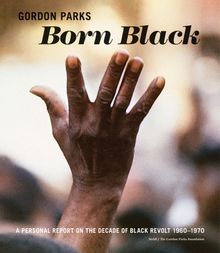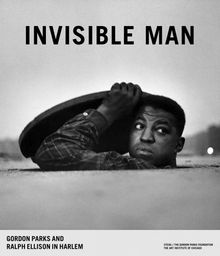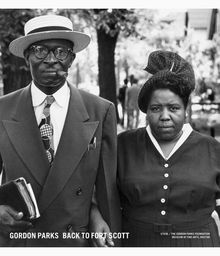PHOTOGRAPHY MONOGRAPHS
|
|
STATUS: Forthcoming | 9/30/2025 This title is not yet published in the U.S. To pre-order or receive notice when the book is available, please email orders @ artbook.com |
 Gordon Parks: American Gothic
Gordon Parks: American Gothic
Gordon Parks and Ella Watson
Published by Steidl/The Gordon Parks Foundation/Minneapolis Institute of Art.
Edited with text by Casey Riley, Philip Brookman. Text by Melanee C. Harvey, Hank Willis Thomas, Salamishah Tillet, Deborah Willis.
Gordon Parks’ 1942 portrait of government worker Ella Watson, American Gothic, is among the most celebrated photographs of the 20th century. The photograph not only connects the intimacy of one person’s life with a national state of affairs but also engages with a larger history of American images by referring to and reinterpreting Grant Wood’s celebrated 1930 painting of the same name. Created as part of an extensive collaboration between the photographer and his subject, it is at once a record of one woman’s position within the racial, professional and economic hierarchies that stratified the nation’s capital and Parks’ visual reckoning with the realities of living in racially segregated Washington, D.C.
Through his work with Watson—a custodian in the government building where he worked—Parks composed an intimate portrait of Black life by focusing on everyday activities, from work routines to family meals and church services. The resulting photographs trace a remarkably intimate portrait of Watson as a multidimensional figure, cherished by her community and vitally important within the civic sphere. American Gothic: Gordon Parks and Ella Watson provides a comprehensive overview of this pivotal series of photographs, including more than 50 images—some never before published—and additional archival material.
Gordon Parks (1912–2006) was an acclaimed American photographer and film director prominent in U.S. documentary photojournalism, particularly in issues of civil rights and poverty. His many photographic series include his iconic photos of poor Americans during the 1940s (taken for the Farm Security Administration Program) and his photographic essays for Life magazine. He directed the films Shaft, Shaft’s Big Score and the semiautobiographical The Learning Tree.
PUBLISHER
Steidl/The Gordon Parks Foundation/Minneapolis Institute of Art
BOOK FORMAT
Clth, 9.75 x 11.5 in. / 192 pgs / 53 color / 83 bw.
PUBLISHING STATUS
Pub Date 4/23/2024
Active
DISTRIBUTION
D.A.P. Exclusive
Catalog: SPRING 2024 p. 5
PRODUCT DETAILS
ISBN 9783969992517 TRADE
List Price: $65.00 CAD $95.00
AVAILABILITY
Out of stock
STATUS: Out of stock Temporarily out of stock pending additional inventory. |
 Gordon Parks: Born Black
Gordon Parks: Born Black
A Personal Report on the Decade of Black Revolt 1960–1970
Published by Steidl/The Gordon Parks Foundation.
Edited with text by Peter W. Kunhardt Jr., Michal Raz-Russo. Text by Jelani Cobb, Nicole R. Fleetwood.
Originally published in 1971, Gordon Parks’ Born Black was the first book to unite his writing and his photography and also the first to provide a focused survey of Parks’ documentation of a crucial time for the civil rights and Black Power movements.
More than 50 years later, this expanded edition illuminates Parks’ vision for the book and offers deeper insight into the series contained within. The original publication featured nine articles commissioned by Life magazine from 1963 to 1970 supplemented with later commentary by Parks and presented as his personal account of these important historical moments. Born Black includes the original text and images, as well as additional photographs from each series, spreads from the 1971 book, early correspondence and reproductions of related Life articles.
The nine series included in Born Black include a rare glimpse inside San Quentin State Prison; extensive documentation of the Black Muslim movement and the Black Panthers; his commentaries on the deaths of civil rights leaders Malcolm X and Martin Luther King, Jr.; intimate portrait studies of Stokely Carmichael, Muhammad Ali and Eldridge Cleaver; and a narrative of the daily life of the impoverished Fontenelle family in Harlem. These selections have come to define Parks' legendary career as a photographer and activist. This reimagined, comprehensive edition of Born Black highlights the lasting legacy of these projects and their importance to our understanding of critical years in American history.
PUBLISHER
Steidl/The Gordon Parks Foundation
BOOK FORMAT
Clth, 9.75 x 11.5 in. / 304 pgs / 116 color / 86 bw.
PUBLISHING STATUS
Pub Date 6/25/2024
Active
DISTRIBUTION
D.A.P. Exclusive
Catalog: SPRING 2024 p. 6
PRODUCT DETAILS
ISBN 9783969992289 TRADE
List Price: $65.00 CAD $88.00
AVAILABILITY
In stock
in stock $65.00 Free Shipping UPS GROUND IN THE CONTINENTAL U.S. |
 Gordon Parks: Pittsburgh Grease Plant, 1944/46
Gordon Parks: Pittsburgh Grease Plant, 1944/46
Published by Steidl/The Gordon Parks Foundation/Carnegie Museum of Art.
Edited by Dan Leers. Text by Philip Brookman, Mark Whitaker, LaToya Ruby Frazier, Peter W. Kunhardt, Jr., Eric Crosby.
By 1944, Gordon Parks had established himself as a photographer who freely navigated the fields of press and commercial photography, with an unparalleled humanist perspective. That year, Roy Stryker—the former Farm Security Administration official who was now heading the public relations department for the Standard Oil Company (New Jersey)—commissioned Parks to travel to Pittsburgh, Pennsylvania, to document the Penola, Inc. Grease Plant.
Employing his signature style, Parks spent two years chronicling the plant’s industry—critical to Pittsburgh’s history and character—by photographing its workers. The resulting photographs, dramatically staged and lit and striking in their composition, showed the range of activities engaged in by Black and white workers, divided as they were by roles, race and class. The images were used as marketing materials and made available to local and national newspapers, as well as corporate magazines and newsletters. However, they served as much more than documentation of industry, enduring as an exploration of labor and its social and economic ramifications in World War II America by one of the most influential artists of the 20th century.
Featuring more than 100 photographs, many previously unpublished, this is the first book to focus exclusively on Parks’ photographs for the Standard Oil Company, illuminating an important chapter in his career prior to his landmark career as a staff photographer for Life.
Gordon Parks was born into poverty and segregation in Fort Scott, Kansas, in 1912. He worked as a brothel pianist and railcar porter, among other jobs, before buying a camera at a pawnshop, training himself and becoming a photographer. In addition to his tenures photographing for the FSA (1941–45) and Life magazine (1948–72), Parks evolved into a modern-day Renaissance man, finding success as a film director, writer and composer. He died in 2006.
PUBLISHER
Steidl/The Gordon Parks Foundation/Carnegie Museum of Art
BOOK FORMAT
Clth, 9.75 x 11.5 in. / 176 pgs / 110 bw.
PUBLISHING STATUS
Pub Date 6/28/2022
Active
DISTRIBUTION
D.A.P. Exclusive
Catalog: FALL 2021 p. 21
PRODUCT DETAILS
ISBN 9783969990056 TRADE
List Price: $65.00 CAD $88.00
AVAILABILITY
In stock
in stock $65.00 Free Shipping UPS GROUND IN THE CONTINENTAL U.S. |
 Gordon Parks: Stokely Carmichael and Black Power
Gordon Parks: Stokely Carmichael and Black Power
Published by Steidl/The Gordon Parks Foundation/Museum of Fine Arts, Houston.
Edited with text by Lisa Volpe. Text by Cedric Johnson.
Gordon Parks’ 1967 Life magazine essay “Whip of Black Power” is a nuanced profile of the young, controversial civil rights leader Stokely Carmichael. As chairman of the Student Nonviolent Coordinating Committee, Carmichael gained national attention and inspired media backlash when he issued the call for Black Power in Greenwood, Mississippi, in June 1966. Parks shadowed him from the fall of 1966 to the spring of 1967, as Carmichael gave speeches, headed meetings and promoted the growing Black Power movement. Parks’ photos and writing addressed Carmichael’s intelligence and humor, presenting the whole man behind the headline-making speeches and revealing his own advocacy of Black Power and its message of self-determination and love.
Stokely Carmichael and Black Power delves into Parks’ groundbreaking presentation of Carmichael, with analysis of his images and accompanying text about the charismatic leader. Lisa Volpe explores Parks’ complex understanding of the movement and its leader, and Cedric Johnson frames Black Power within the heightened political moment of the late 1960s. Carmichael’s own voice is represented through a reprint of his important 1966 essay “What We Want.”
Gordon Parks (1912–2006) was a photographer, filmmaker, musician and author whose 50-year career focused on American culture, social justice, the civil rights movement and the Black American experience. Born into poverty and segregation in Fort Scott, Kansas, Parks was awarded the Julius Rosenwald Fellowship in 1942, which led to a position with the Farm Security Administration. In 1969 he became the first Black American to write and direct a major feature film, The Learning Tree, and his next directorial endeavor, Shaft (1971), helped define a film genre.
PUBLISHER
Steidl/The Gordon Parks Foundation/Museum of Fine Arts, Houston
BOOK FORMAT
Clth, 9.75 x 11.5 in. / 176 pgs / 30 color / 53 bw.
PUBLISHING STATUS
Pub Date 9/27/2022
Active
DISTRIBUTION
D.A.P. Exclusive
Catalog: FALL 2022 p. 10
PRODUCT DETAILS
ISBN 9783969990940 TRADE
List Price: $50.00 CAD $68.00
AVAILABILITY
In stock
in stock $50.00 Free Shipping UPS GROUND IN THE CONTINENTAL U.S. |
 Gordon Parks: Segregation Story
Gordon Parks: Segregation Story
Published by Steidl/The Gordon Parks Foundation.
By Gordon Parks. Edited by Peter W. Kunhardt, Jr, Michal Raz-Russo. Text by Maurice Berger, Dawoud Bey, Charlayne Hunter-Gault.
This expanded edition of Gordon Parks: Segregation Story includes around 30 previously unpublished photographs, as well as enhanced reproductions created from Parks’ original color transparencies; newly discovered descriptions Parks wrote for the photographs; a manuscript of film-developing instructions and captions Parks authored with Samuel F. Yette; previously published texts by the late art historian Maurice Berger and the esteemed journalist and civil rights activist Charlayne Hunter-Gault; and a new essay by artist Dawoud Bey.
After the photographs were first presented in a 1956 issue of Life magazine, the bulk of Parks’ assignment was thought to be lost. In 2011, five years after Parks’ death, the Gordon Parks Foundation found more than 200 color transparencies belonging to the series. In 2014 the series was first published as a book, and since then new photographs have been uncovered.
In the summer of 1956, Life magazine sent Gordon Parks to Alabama to document the daily realities of African Americans living under Jim Crow laws in the rural South. The resulting color photographs are among Parks’ most powerful images, and, in the decades since, have become emblematic representations of race relations in America. Pursued at grave danger to the photographer himself, the project was an important chapter in Parks’ career-long endeavor to use the camera as a weapon for social change.
Gordon Parks (1912–2006) was born into poverty and segregation in Fort Scott, Kansas, in 1912. An itinerant laborer, he worked as a brothel pianist and railcar porter, among other jobs, before buying a camera at a pawnshop, training himself and becoming a photographer. He evolved into a modern-day Renaissance man, finding success as a film director, writer and composer. The first African American director to helm a major motion picture, he helped launch the blaxploitation genre with his film Shaft (1971). Parks died in 2006.
PUBLISHER
Steidl/The Gordon Parks Foundation
BOOK FORMAT
Clth, 9.75 x 11.5 in. / 208 pgs / 105 color.
PUBLISHING STATUS
Pub Date 9/27/2022
Active
DISTRIBUTION
D.A.P. Exclusive
Catalog: SPRING 2022 p. 17
PRODUCT DETAILS
ISBN 9783969990261 TRADE
List Price: $65.00 CAD $88.00
AVAILABILITY
Out of stock
STATUS: Out of stock Temporarily out of stock pending additional inventory. |
 Gordon Parks: Muhammad Ali
Gordon Parks: Muhammad Ali
Published by Steidl/The Gordon Parks Foundation/The Nelson-Atkins Museum of Art.
Edited by Peter W. Kunhardt, Jr., Paul Roth, April Watson. Foreword by Peter W. Kunhardt Jr., Julián Zugazagoitia. Introduction by Kareem Abdul-Jabbar. Text by Gerald Early, April Watson.
In 1966 Life magazine assigned famed photographer Gordon Parks to cover Muhammad Ali, the brash young boxing champion. Four years later in 1970, the two came together again for a second feature story in “The Great American Magazine.” These encounters framed a critical passage in the career of the controversial heavyweight, whose antiwar and black separatist views had led to widespread vilification in the United States. They also marked a significant moment of transition for Parks, then following up his remarkable success in photojournalism with new projects as an author, filmmaker and composer.
Collaborating on these two stories, Parks and Ali transcended their routine roles as journalist and athlete to make sense of an epoch and the American struggle against racial inequality, in which both were key players. Parks’ intimate perspective on Ali during this crucial period is indispensable to understanding the boxer called “the greatest of all time.” This book includes an expansive selection of photographs from Parks’ original reportage, many never before published, as well as reproductions of his original stories as they appeared in Life magazine.
Gordon Parks was born into poverty and segregation in Fort Scott, Kansas, in 1912. An itinerant laborer, he worked as a brothel pianist and railcar porter, among other jobs, before buying a camera at a pawnshop, training himself, and becoming a photographer. In addition to his storied tenures photographing for the Farm Security Administration (1941–45) and Life magazine (1948–72), Parks evolved into a modern-day Renaissance man, finding success as a film director, writer and composer. The first African American director to helm a major motion picture, he helped launch the blaxploitation genre with his film Shaft (1971). He wrote numerous memoirs, novels and books of poetry, and received many awards and more than 50 honorary degrees. Parks died in 2006.
PUBLISHER
Steidl/The Gordon Parks Foundation/The Nelson-Atkins Museum of Art
BOOK FORMAT
Clth, 9.75 x 11.5 in. / 176 pgs / 5 color / 110 bw.
PUBLISHING STATUS
Pub Date 2/11/2020
Active
DISTRIBUTION
D.A.P. Exclusive
Catalog: FALL 2019 p. 12
PRODUCT DETAILS
ISBN 9783958296190 TRADE
List Price: $55.00 CAD $75.00
AVAILABILITY
Out of stock
STATUS: Out of stock Temporarily out of stock pending additional inventory. |
 Gordon Parks: The Atmosphere of Crime, 1957
Gordon Parks: The Atmosphere of Crime, 1957
Published by Steidl/The Gordon Parks Foundation.
Edited with text by Sarah Hermanson Meister. Foreword by Peter W. Kunhardt Jr., Glenn D. Lowry. Text by Nicole Fleetwood, Bryan Stevenson.
A New York Times Book Review 2020 holiday gift guide pick
When Life magazine asked Gordon Parks to illustrate a recurring series of articles on crime in the United States in 1957, he had already been a staff photographer for nearly a decade, the first African American to hold this position. Parks embarked on a six-week journey that took him and a reporter to the streets of New York, Chicago, San Francisco and Los Angeles. Unlike much of his prior work, the images made were in color. The resulting eight-page photo-essay “The Atmosphere of Crime” was noteworthy not only for its bold aesthetic sophistication, but also for how it challenged stereotypes about criminality then pervasive in the mainstream media. They provided a richly hued, cinematic portrayal of a largely hidden world: that of violence, police work and incarceration, seen with empathy and candor.
Parks rejected clichés of delinquency, drug use and corruption, opting for a more nuanced view that reflected the social and economic factors tied to criminal behavior and afforded a rare window into the working lives of those charged with preventing and prosecuting it. Transcending the romanticism of the gangster film, the suspense of the crime caper and the racially biased depictions of criminality then prevalent in American popular culture, Parks coaxed his camera to record reality so vividly and compellingly that it would allow Life’s readers to see the complexity of these chronically oversimplified situations. The Atmosphere of Crime, 1957 includes an expansive selection of never-before-published photographs from Parks’ original reportage.
Gordon Parks was born into poverty and segregation in Fort Scott, Kansas, in 1912. An itinerant laborer, he worked as a brothel pianist and railcar porter, among other jobs, before buying a camera at a pawnshop, training himself and becoming a photographer. He evolved into a modern-day Renaissance man, finding success as a film director, writer and composer. The first African-American director to helm a major motion picture, he helped launch the blaxploitation genre with his film Shaft (1971). Parks died in 2006.
PUBLISHER
Steidl/The Gordon Parks Foundation
BOOK FORMAT
Clth, 9.75 x 11.5 in. / 168 pgs / 60 color / 10 bw.
PUBLISHING STATUS
Pub Date 6/16/2020
Active
DISTRIBUTION
D.A.P. Exclusive
Catalog: SPRING 2020 p. 35
PRODUCT DETAILS
ISBN 9783958296961 TRADE
List Price: $50.00 CAD $65.00
AVAILABILITY
Out of stock
STATUS: Out of stock Temporarily out of stock pending additional inventory. |
 Gordon Parks: The Flavio Story
Gordon Parks: The Flavio Story
Published by Steidl/The Gordon Parks Foundation.
Edited with text by Paul Roth, Amanda Maddox. Foreword by Peter W. Kunhardt, Jr., Flávio Pinheiro, Timothy Potts. Text by Sérgio Burgi, Beatriz Jaguaribe, Maria Alice Rezende de Carvalho, Natalie Spagnol.
This book explores a once-popular picture story by Gordon Parks and the extraordinary chain of events it prompted. Published in Life magazine in June 1961 as “Poverty: Freedom’s Fearful Foe,” this empathetic photo-essay profiled the da Silva family, living in a hillside favela near a wealthy enclave of Rio de Janeiro. Focused primarily on the eldest son Flavio, an industrious 12-year-old suffering from crippling asthma, Parks’ story elicited more than 3,000 letters and $25,000 in donations from Life readers to help the family and the favela.
In Brazil the story sparked controversy; one news magazine, O Cruzeiro, retaliated against Life and sent photographer Henri Ballot to document poverty in New York City. Undeterred, Life embarked on a multi-year “rescue” effort that involved moving Flavio to a Denver hospital, relocating the family to a new home and administering funds to support the favela. The story, as well as Parks’ relationship to Flavio, continued to develop over many years. The details of this extraordinary history provide a fascinating example of US exceptionalism during the early 1960s and a revealing look inside the power and cultural force of the “Great American Magazine.”
PUBLISHER
Steidl/The Gordon Parks Foundation
BOOK FORMAT
Clth, 9.75 x 11.5 in. / 300 pgs / 50 color / 150 bw.
PUBLISHING STATUS
Pub Date 5/22/2018
Active
DISTRIBUTION
D.A.P. Exclusive
Catalog: FALL 2017 p. 43
PRODUCT DETAILS
ISBN 9783958293441 TRADE
List Price: $65.00 CAD $87.00
AVAILABILITY
Out of stock
STATUS: Out of stock Temporarily out of stock pending additional inventory. |
 Gordon Parks: The New Tide
Gordon Parks: The New Tide
Early Work 1940–1950
Published by Steidl/Gordon Parks Foundation/National Gallery of Art.
Edited by Peter W. Kunhardt, Jr., Philip Brookman. Foreword by Peter W. Kunhardt, Jr., Earl A. Powell III. Introduction by Sarah Lewis. Text by Maurice Berger, Philip Brookman, Richard J. Powell, Deborah Willis.
Focusing on new research and access to forgotten pictures, The New Tide, Early Work 1940–1950 documents the importance of these years in shaping Gordon Parks' passionate vision. The book brings together photographs and publications made during the first and most formative decade of his 65-year career.
During the 1940s Parks' photographic ambitions grew to express a profound understanding of his cultural and political experiences. From the first photographs he published in Saint Paul, Minnesota, and his relationship to the Chicago Black Renaissance, to his mentorship with Roy Stryker and his breakthrough work for America's influential picture magazines—including Ebony and Life—this book traces Parks' rapid evolution from an accomplished, self-taught practitioner to a groundbreaking artistic and journalistic voice.
Gordon Parks was born into poverty and segregation in Fort Scott, Kansas, in 1912. An itinerant laborer, he worked as a brothel pianist and railcar porter, among other jobs, before buying a camera at a pawnshop, training himself and becoming a photographer. During his storied tenures photographing for the Farm Security Administration (1941–45) and Life magazine (1948–72), Parks evolved into a modern-day Renaissance man, finding success as a film director, writer and composer. The first African American director to helm a major motion picture, he helped launch the blaxploitation genre with his film Shaft (1971). He wrote numerous memoirs, novels and books of poetry, and received many awards, including the National Medal of Arts, and more than 50 honorary degrees. Parks died in 2006.
PUBLISHER
Steidl/Gordon Parks Foundation/National Gallery of Art
BOOK FORMAT
Clth, 9.75 x 11.5 in. / 304 pgs / 42 color / 126 bw.
PUBLISHING STATUS
Pub Date 11/20/2018
Active
DISTRIBUTION
D.A.P. Exclusive
Catalog: FALL 2018 p. 16
PRODUCT DETAILS
ISBN 9783958294943 TRADE
List Price: $65.00 CAD $92.00
AVAILABILITY
Out of stock
STATUS: Out of stock Temporarily out of stock pending additional inventory. |
 Gordon Parks: Collected Works
Gordon Parks: Collected Works
Study Edition
Published by Steidl/The Gordon Parks Foundation.
Edited by Peter W. Kunhardt, Jr., Paul Roth. Text by Henry Louis Gates, Jr., Deborah Willis, Maurice Berger, Barbara Baker Burrows, Paul Roth, Gordon Parks.
This five-volume collection surveys five decades of Gordon Parks’ (1912–2006) photography. It is the most extensive publication to document his legendary career. Widely recognized as the most important and influential African-American photographer of the 20th century, Parks combined a unique documentary and artistic style with a profound commitment to social justice.
Working first for the Farm Security Administration and later for Life magazine, he specialized in extended-narrative picture stories on difficult subject matter. Covering crime, poverty, segregation, the politics of race and class, and controversial personalities, Parks became legendary for his ability to meld penetrating insight with a lyrical aesthetic. He was thus able to introduce a broad and diverse public to people, issues and ideas they might otherwise have ignored. Parks was remarkably versatile, traveling the world to photograph news events and fashion, as well as the worlds of art, literature, music, theater and film. Later in life, he reconceived his vision in fundamentally personal and poetic terms, producing color photographs that were allusive rather than descriptive, symbolic rather than literal.
PUBLISHER
Steidl/The Gordon Parks Foundation
BOOK FORMAT
Clth, 5 vols, 9.75 x 11.5 in. / 1,084 pgs / illustrated throughout.
PUBLISHING STATUS
Pub Date 5/23/2017
Out of print
DISTRIBUTION
D.A.P. Exclusive
Catalog: SPRING 2017 p. 124
PRODUCT DETAILS
ISBN 9783958292628 TRADE
List Price: $145.00 CAD $195.00
AVAILABILITY
Not available
STATUS: Out of print | 00/00/00 For assistance locating a copy, please see our list of recommended out of print specialists |
 Invisible Man: Gordon Parks and Ralph Ellison in Harlem
Invisible Man: Gordon Parks and Ralph Ellison in Harlem
Published by Steidl/The Gordon Parks Foundation/The Art Institute of Chicago.
Foreword by Peter W. Kunhardt Jr., Douglas Druick. Introduction by Matthew S. Witkovsky, John F. Callahan. Text by Michal Raz-Russo, Jean-Christophe Cloutier.
It is relatively unknown that the photographer Gordon Parks was close friends with Ralph Ellison, author of the acclaimed 1952 novel Invisible Man. Even less known is the fact that their common vision of racial injustices, coupled with a shared belief in the communicative power of photography, inspired collaboration on two important projects, in 1948 and 1952. Capitalizing on the growing popularity of the picture press, Parks and Ellison first joined forces on an essay titled "Harlem Is Nowhere" for ‘48: The Magazine of the Year.
Conceived while Ellison was already three years into writing Invisible Man, this illustrated essay was centered on the Lafargue Clinic, the first non-segregated psychiatric clinic in New York City, as a case study for the social and economic conditions in Harlem. He chose Parks to create the accompanying photographs, and during the winter of 1948, the two roamed the streets of Harlem, with Parks photographing under the guidance of Ellison’s writing. In 1952 the two collaborated again on "A Man Becomes Invisible" for the August 25 issue of Life, which promoted Ellison’s newly released novel. This is the first publication on Parks’ and Ellison’s two collaborations, one of which was lost, while the other was published only in reduced form.
Gordon Parks was born in Fort Scott, Kansas, in 1912. In addition to his storied tenures photographing for the Farm Security Administration (1941–45) and Life (1948–72), Parks found success as a film director, introducing Blaxploitation through his film Shaft (1971). Parks died in 2006.
Ralph Ellison was born in Oklahoma City in 1913. He enrolled at Booker T. Washington’s Tuskegee Institute in Macon County, Alabama, as a music major and later turned to writing essays and short stories for publications such as New Masses, The Negro Quarterly, The New Republic and Saturday Review. Invisible Man won the National Book Award in 1953. Ellison published two collections of essays: Shadow and Act (1964) and Going to the Territory (1986). He died in 1994.
PUBLISHER
Steidl/The Gordon Parks Foundation/The Art Institute of Chicago
BOOK FORMAT
Clth, 9.75 x 11.5 in. / 128 pgs / 79 bw.
PUBLISHING STATUS
Pub Date 6/28/2016
Active
DISTRIBUTION
D.A.P. Exclusive
Catalog: SPRING 2016 p. 5
PRODUCT DETAILS
ISBN 9783958291096 TRADE
List Price: $45.00 CAD $60.00
AVAILABILITY
Out of stock
STATUS: Out of stock Temporarily out of stock pending additional inventory. |
 Gordon Parks: I Am You
Gordon Parks: I Am You
Selected Works 1934-1978
Published by Steidl/The Gordon Parks Foundation/C/O Berlin.
Edited with text by Peter W. Kunhardt, Jr., Felix Hoffman.
Reportage for major magazines dominated Parks’ work from 1948 to 1972. He chronicled black America’s struggle for equality, exposing the harsh realities of life in Harlem, institutionalized racism and shocking poverty. Parks was equally accomplished as a portraitist, capturing figures such as Malcolm X, Martin Luther King, Duke Ellington and Ingrid Bergman. He turned his attention to film in the 1960s with social documentaries, as well as the cult classic Shaft (1971).
This volume traces all the threads of Parks’ achievement, examining the interaction between his photographic and filmic visions.
Gordon Parks (1912–2006) was born in Fort Scott, Kansas. He worked as a brothel pianist and railcar porter, among other jobs, before buying a camera at a pawnshop, training himself, and becoming a photographer. In addition to his tenures photographing for the Farm Security Administration (1941–45) and Life (1948–72), Parks evolved into a modern-day Renaissance man, finding success as a film director, writer and composer. He wrote numerous memoirs, novels and poetry, and received many awards, including the National Medal of Arts and more than 50 honorary degrees.
PUBLISHER
Steidl/The Gordon Parks Foundation/C/O Berlin
BOOK FORMAT
Hardcover, 9.75 x 11.5 in. / 240 pgs / 200 color & bw.
PUBLISHING STATUS
Pub Date 11/22/2016
Active
DISTRIBUTION
D.A.P. Exclusive
Catalog: FALL 2016 p. 31
PRODUCT DETAILS
ISBN 9783958291829 TRADE
List Price: $50.00 CAD $67.50
AVAILABILITY
Out of stock
STATUS: Out of stock Temporarily out of stock pending additional inventory. |
 Gordon Parks: Segregation Story
Gordon Parks: Segregation Story
Published by Steidl.
Foreword by Peter W. Kunhardt, Jr., Brett Abbott. Introduction by Charlayne Hunter-Gault. Text by Maurice Berger.
PUBLISHER
Steidl
BOOK FORMAT
Hardcover, 10 x 11.5 in. / 112 pgs / illustrated throughout.
PUBLISHING STATUS
Pub Date 2/28/2015
Out of print
DISTRIBUTION
D.A.P. Exclusive
Catalog: FALL 2014 p. 12
PRODUCT DETAILS
ISBN 9783869308012 TRADE
List Price: $45.00 CAD $60.00
AVAILABILITY
Not available
STATUS: Out of print | 00/00/00 For assistance locating a copy, please see our list of recommended out of print specialists |
 Gordon Parks: Back to Fort Scott
Gordon Parks: Back to Fort Scott
Published by Steidl.
Foreword by Peter W. Kunhardt, Jr. Introduction by Isabel Wilkerson. Text by Karen Haas.
Gordon Parks (1912–2006) was born into poverty and segregation in Fort Scott, Kansas. The self-taught photographer also found success as a film director, author and composer. He was awarded the National Medal of Arts and over 50 honorary degrees.
PUBLISHER
Steidl
BOOK FORMAT
Clth, 10 x 11.5 in. / 144 pgs / 80 color.
PUBLISHING STATUS
Pub Date 5/26/2015
Out of print
DISTRIBUTION
D.A.P. Exclusive
Catalog: SPRING 2015 p. 33
PRODUCT DETAILS
ISBN 9783869309187 TRADE
List Price: $45.00 CAD $60.00
AVAILABILITY
Not available
STATUS: Out of print | 00/00/00 For assistance locating a copy, please see our list of recommended out of print specialists |
 Gordon Parks: The Making of an Argument
Gordon Parks: The Making of an Argument
Published by Steidl.
PUBLISHER
Steidl
BOOK FORMAT
Slip, clth, 5 vols, 9.75 x 11.5 in. / 136 pgs / illustrated throughout.
PUBLISHING STATUS
Pub Date 10/1/2013
Active
DISTRIBUTION
D.A.P. Exclusive
Catalog: FALL 2014
PRODUCT DETAILS
ISBN 9783869307213 TRADE
List Price: $40.00 CAD $54.00
AVAILABILITY
Out of stock
STATUS: Out of stock Temporarily out of stock pending additional inventory. |
 Gordon Parks: A Harlem Family
Gordon Parks: A Harlem Family
Published by Steidl.
Edited by Thelma Golden, Elizabeth Gwinn, Lauren Haynes. Foreword by Raymond J. McGuire.
PUBLISHER
Steidl
BOOK FORMAT
Clth, 9.75 x 11.5 in. / 112 pgs / illustrated throughout.
PUBLISHING STATUS
Pub Date 1/15/2013
Active
DISTRIBUTION
D.A.P. Exclusive
Catalog: FALL 2014
PRODUCT DETAILS
ISBN 9783869306025 TRADE
List Price: $40.00 CAD $54.00
AVAILABILITY
Out of stock
STATUS: Out of stock Temporarily out of stock pending additional inventory. |
 Gordon Parks: Collected Works
Gordon Parks: Collected Works
Published by Steidl.
Edited by Peter W. Kunhardt, Jr. and Paul Roth. Text by Henry Louis Gates, Jr., Deborah Willis, Maurice Berger, Barbara Baker Burrows, Paul Roth, and Gordon Parks.
PUBLISHER
Steidl
BOOK FORMAT
Slip, clth, 5 vols, 10.5 x 12 in. / 1084 pgs / illustrated throughout.
PUBLISHING STATUS
Pub Date 11/30/2012
Active
DISTRIBUTION
D.A.P. Exclusive
Catalog: FALL 2014 p. 14
PRODUCT DETAILS
ISBN 9783869305301 TRADE
List Price: $185.00 CAD $250.00
AVAILABILITY
Out of stock
STATUS: Out of stock Temporarily out of stock pending additional inventory. |

